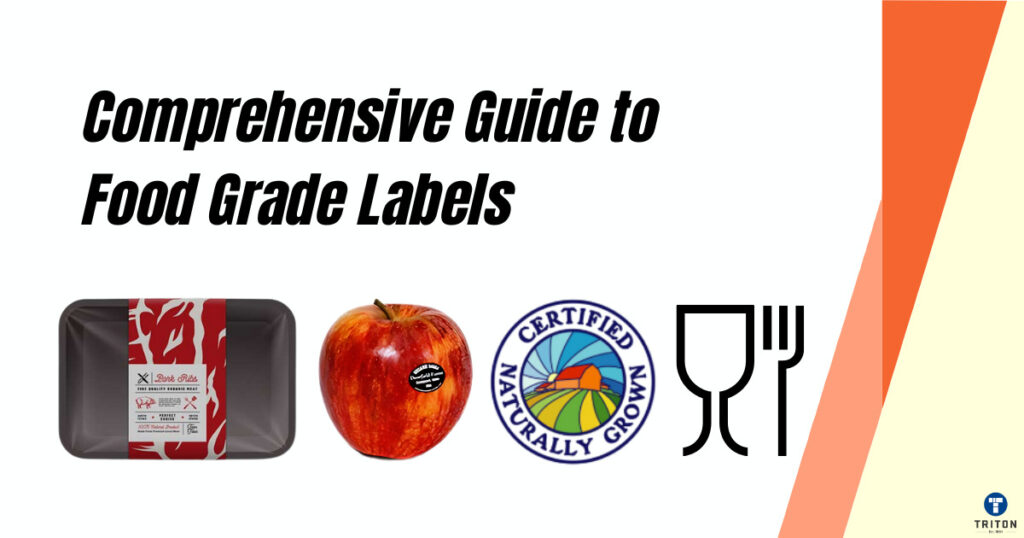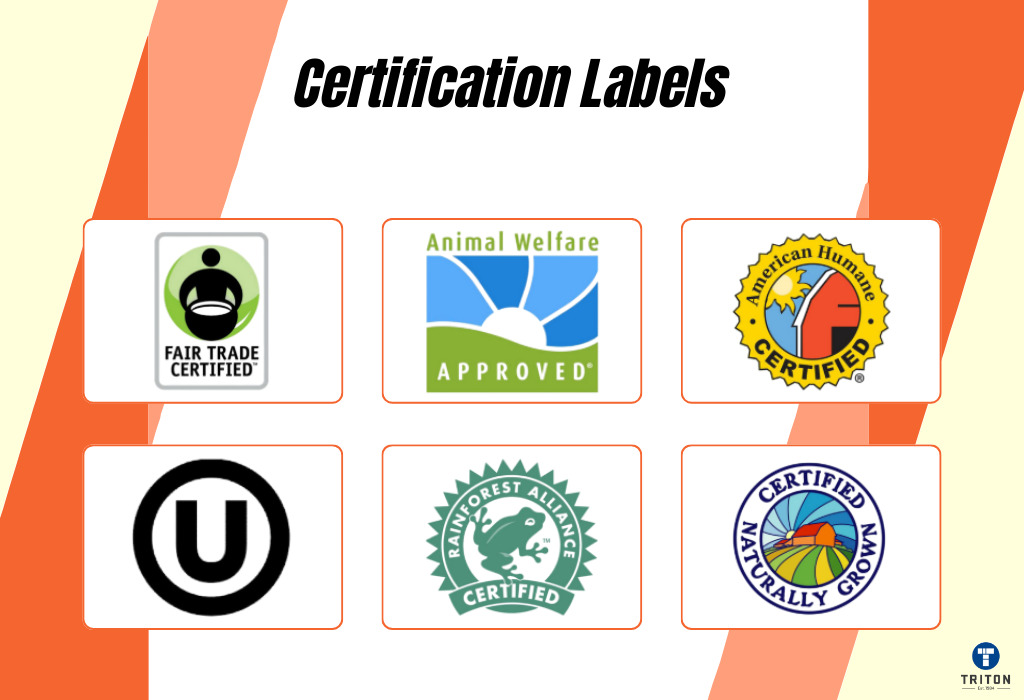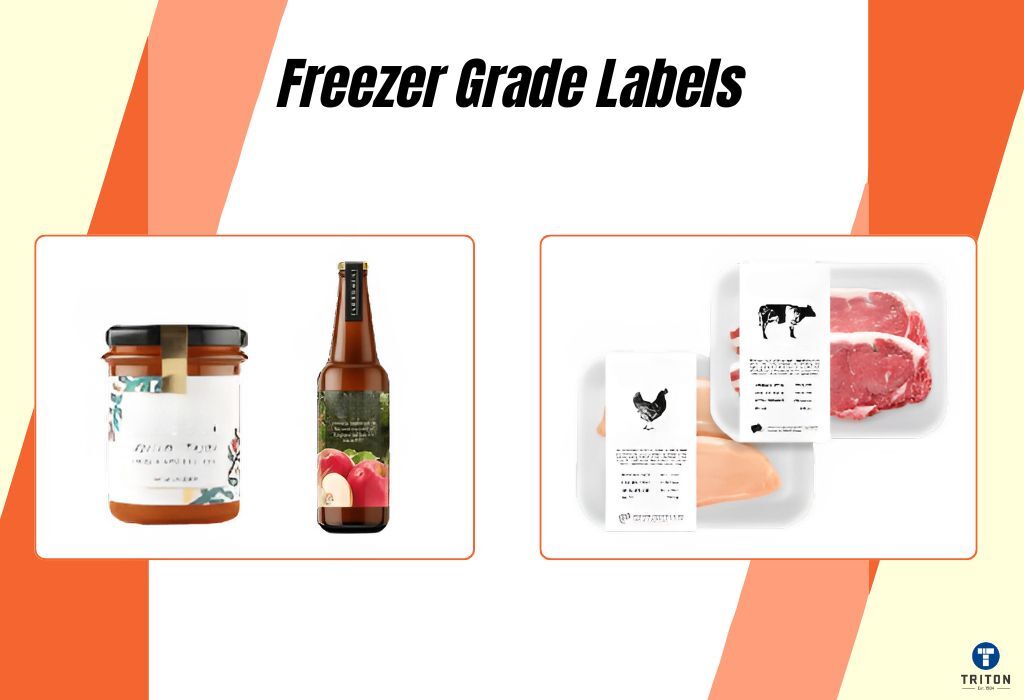
In food labelling, food grade labels refer to labelling materials, including inks and adhesives, that are safe for use on food products. These labels meet regulatory compliance and consumer trust. They use materials such as BPA‑free plastics, non‑toxic adhesives, food‑safe inks, food‑grade laminates and water‑resistant coatings.

Food grade labels are divided into those that contact food directly and those that do not, as well as by their physical design. This system enables businesses to select labels that comply with safety standards and meet packaging requirements.

Direct contact food grade labels are designed for direct application onto food surfaces without compromising safety, taste, or quality. They are manufactured using materials that have been tested for food contact compliance.
For example, some labels are produced from paper that has been treated with food-contact coatings meeting FSANZ and FDA standards, while others are made using food‑grade low‑density polyethylene or biaxially oriented polypropylene films that have been approved for direct food contact.
Adhesives for these labels are typically selected from hot‑melt, water‑based, or silicone‑based formulations. These adhesives are formulated to be non‑toxic and safe for food contact, often based on acrylic or rubber chemistries that comply with established health regulations.
Direct contact labels are widely used on products such as fresh produce, meat, cheese, and bakery items.
Not all rubber-based adhesives are food-safe. Only specific formulations of acrylic and rubber adhesives comply with FDA 21 CFR 175.105 or equivalent standards. |
Indirect food grade labels are applied to packaging surfaces that do not directly contact food, such as secondary or outer packaging.
They are typically manufactured using substrates such as paper, polypropylene, and polyester, chosen for their durability and chemical inertness under expected storage and transport conditions. Although these labels do not physically touch the food, migration of chemical substances from the label – originating from substrates, adhesives, inks, or coatings – may occur via condensation, temperature fluctuations, or vapour transfer.
Indirect label adhesives are selected from hot‐melt, water-based, or silicone-based systems and are subject to rigorous migration testing to ensure compliance with regulatory standards such as FDA 21 CFR Parts 174–179 and EU Regulation No. 10/2011.
Manufacturers use acrylic-based or rubber-based adhesive formulations that have been validated for non-toxicity and minimal migration potential under worst-case scenarios.
Inks and coatings used in printing are also formulated with food-grade compounds, and do not use substances such as lead, non-food-grade plasticisers, and hazardous solvents.
Migration testing is conducted using food simulants that replicate the chemical properties of target food types, and the measured migration must not exceed overall migration limits (e.g., 10 mg/dm² in the EU) or specific migration limits (SMLs) set for individual substances. As environmental conditions (e.g., humidity and temperature) may enhance chemical migration, manufacturers implement barrier coatings and design strategies that reduce exposure. Ultimately, indirect contact labels must be engineered and tested to ensure that any potential migration does not compromise food safety or quality.
In the European Union, the overall migration limit is set at 10 mg/dm² according to EU Regulation No 10/2011. Similarly, the Food Standards Australia New Zealand Code (Standard 1.4.3) specifies an overall migration limit of 10 mg/dm² for food contact materials. In contrast, the U.S. FDA does not impose a uniform overall migration limit; instead, it evaluates individual substances through specific migration limits and the Threshold of Regulation process. |
Linerless labels are self-adhesive labels manufactured without a separate release liner, thereby reducing material waste and enhancing production efficiency.
They are manufactured using food-grade substrates, such as thermal paper for short-term applications or durable films like polypropylene and polyester for longer-lasting use. A precision engineered release coating – applied directly onto the label surface – prevents the labels from sticking to one another during storage or processing.
Pressure-sensitive adhesives, typically formulated with acrylic or rubber chemistries, are applied to these labels to secure firm adhesion across a range of surfaces.
Linerless labels are widely used in the food industry for applications including the packaging of fresh produce, meat, deli items, and takeaway containers.
Wash-off labels are designed to be quickly removed with water, which makes them ideal for reusable packaging and recycling. They are made from materials like paper, polypropylene (PP), and polyethylene (PE) that meet strength tests such as ASTM D882 while still allowing the label to come off easily.
These labels use water-soluble adhesives – often made from polyvinyl alcohol (PVOH) or starch – or low-tack pressure-sensitive adhesives. These adhesives are designed to lose their stickiness (typically about 0.5–1 N/cm) when exposed to water.
This controlled loss creates a temporary bond that holds the label in place during use but lets it peel off completely without any residue when washed.
Wash-off labels are commonly used on glass bottles, plastic containers, and food trays for dairy, beverages, and meal packaging, and they must pass migration tests to ensure they meet food contact safety regulations.
Removable labels stick firmly to surfaces yet peel off easily without leaving any sticky residue or damaging the base material.
They are made from strong substrates like paper, polypropylene (PP), polyester, and vinyl, which meet standard tests for tensile strength and tear resistance (e.g., ASTM D882).
These labels use low-tack or repositionable adhesives which are often rated around 0.5-1 N/cm peel adhesion, that offer a strong bond during use but allow repositioning or removal without performance loss.
Removable labels are commonly applied in the food industry for temporary applications such as price tagging, promotional markings, or date coding on items like plastic containers, glass jars, and cardboard packaging.
Tamper-evident labels are engineered to clearly show signs of tampering if someone tries to remove or alter them. They are made from substrates such as paper, polyester, vinyl, and specially formulated destructible films that fracture or leave a visible mark when disturbed.
These labels use high-performance adhesives – typically acrylic or security-grade formulations with peel strengths around 2–3 N/cm – that bond strongly to surfaces, ensuring that any attempt at removal results in a controlled failure (either cohesive or adhesive). This failure creates an irreversible, visible indicator of tampering.
Tamper-evident labels are widely used in food packaging, takeaway containers, sealed jars, and delivery bags to help maintain product integrity and protect consumer safety.

Freezer-grade labels are used in frozen food packaging, such as ice cream, frozen meat, seafood, and dairy products. They are made from freeze-resistant substrates like polypropylene (PP) and polyester, which maintain flexibility and tensile strength at temperatures as low as -20°C to -40°C.
These labels are engineered to resist freeze–thaw cycles without cracking or becoming brittle. They use specialized adhesives – such as hot melt adhesives (HMAs) with peel strengths around 1.5-2.5 N/cm and epoxy formulations that cure to form cross-linked networks for strong adhesion in refrigerators and freezers.
Heat-resistant labels are engineered for high-temperature conditions, such as microwave heating, oven baking, boiling, and sterilisation. They are made from substrates with high thermal stability like polyimide films that withstand up to 300°C, advanced polyesters, and aluminium. These materials maintain their mechanical integrity and resist thermal degradation during extended heat exposure.
They use specialised adhesives, including silicone-based systems and high-temperature acrylic formulations, which retain strong adhesion at temperatures between 150°C and 250°C. This ensures that labels remain firmly attached on packaging for ready-to-eat meals, canned goods undergoing retort sterilisation (typically at 121°C), and baked products exposed to oven temperatures above 180°C.
For example, labels on ready-to-eat meals must remain legible during microwave heating at around 100°C, while those on canned soups and sauces must endure high-temperature processing without delamination.
The choice of printing method directly impacts the quality, cost, and production speed of food labels, while the adhesive used determines how well labels stick under various conditions. Selecting the right combination ensures that labels meet functional, regulatory, and aesthetic requirements.
Food labels can be printed by several methods, including thermal transfer, direct thermal, inkjet, and flexographic printing.
Flexographic printing is cost-effective for high-volume production and uses rubber or photopolymer plates with water-based inks; typical drying times are 5 – 10 seconds per label, though resolution is lower.
Digital printing offers high resolution and quick design changes, ideal for short runs and customised jobs. In some cases, UV-curable inks are used because they rapidly cure under UV light and have very low levels of volatile organic compounds (VOCs), typically below 50 g/L, which helps in compliance with food safety standards (e.g., FDA 21 CFR 176 and EU Regulation No. 10/2011).
Adhesives for food labels must be chosen based on the product’s use and storage conditions. Permanent adhesives, often based on epoxy or acrylate chemistries, typically offer peel strengths of 1.5 – 2.5 N/cm and ensure that labels remain attached throughout a product’s lifecycle, such as on canned goods.
Removable adhesives, usually low-tack or repositionable formulations, allow labels to be peeled off cleanly without leaving residue, making them suitable for temporary applications like promotions or price tags. Freezer-grade adhesives are specially formulated to maintain adhesion at sub-zero temperatures (as low as -20°C) by incorporating freeze-resistant polymers.
For labels in direct food contact, food-safe adhesives must be non-toxic, exhibit minimal residual monomer content (often below 0.5%), and meet strict regulatory standards such as those set by FDA and FSANZ.
In addition to printing and adhesive selection, several factors further influence label performance and safety.
Release liners protect the adhesive layer before application and are designed to separate cleanly during processing.
Hot-melt adhesives, applied as liquids at around 150°C and cooled rapidly (curing within 10–30 seconds), form strong bonds on various substrates.
Pressure-sensitive adhesives (PSAs), which activate with light pressure, exhibit typical tack values between 200 and 400 g/in² and require no heat or water for adhesion.
Compatibility between the adhesive, printing inks, and substrate is critical to prevent chemical interactions that might lead to migration of harmful substances into food.
Together, these considerations complement the printing and adhesive methods to guarantee that labels not only meet functional and regulatory requirements but also maintain product safety and quality under various conditions.
Food labelling compliance varies across regions, with different regulatory frameworks governing ingredient disclosure, allergen declarations, nutrition facts, and traceability. This section offers a general overview of the regulations for food-grade labels. Please refer to official regulatory websites for more detailed information. Understanding these requirements is essential for market entry and regulatory compliance.
Australia and New Zealand collaborate on food standards through the Food Standards Australia New Zealand (FSANZ) system. FSANZ is responsible for developing and maintaining the Food Standards Code, which applies to both countries.The Food Standards Code mandates that packaged foods include:
Chapters 3 and 4 of the Code contain standards exclusive to Australia, focusing on food safety practices for food businesses and primary production.
In the United States, the Food and Drug Administration (FDA) and the U.S. Department of Agriculture’s Food Safety and Inspection Service (USDA FSIS) oversee food labelling.The FDA oversees labeling for most foods, such as cereals, snacks, and beverages, under laws like the Federal Food, Drug, and Cosmetic Act (FFDCA) and the Fair Packaging and Labeling Act (FPLA). Meanwhile, the USDA FSIS regulates labels for meat, poultry, and processed egg products under the Federal Meat Inspection Act and the Poultry Products Inspection Act.
Labels must include:
Both imperial (like ounces) and metric (like grams) measurements are allowed on labels, but metric units are required on most consumer products. Allergen labeling is crucial; the top nine allergens must be declared either in the ingredients list or in a separate “Contains: [allergen names]” statement. Nutrient content claims like “healthy” or “low fat” are regulated and only allowed if they meet FDA criteria.
For meat, poultry, and processed egg products, labels have additional requirements:
Labels with special claims, like “organic” or “no nitrates added,” must be submitted to FSIS for approval. While the FDA does not pre-approve labels, companies must ensure their labels comply with regulations to avoid enforcement actions. For detailed FDA requirements, refer to 21 CFR Part 101 (Food Labeling). The FDA’s Food Labeling Guide, revised in 2013, is a key resource for the industry. For FSIS guidelines, see 9 CFR Parts 317 and 381, and the FSIS Labeling Compliance Guide. The USDA organic seal has separate rules outlined in 7 CFR Part 205. Manufacturers typically follow FDA guidelines for label layout, ensuring consistency and clarity for consumers.
Additionally, certain products have specific labeling requirements. For example, juice products must declare the percentage of juice they contain; certain raw meats must have safe handling instructions; and seafood has country-of-origin labeling (COOL) requirements, administered by USDA’s Agricultural Marketing Service. It’s the manufacturer’s responsibility to ensure labels are not false or misleading. Enforcement actions for non-compliant labels can include warning letters, recalls, or import refusals.
In the United Kingdom, food labeling is governed by the Food Information Regulations 2014, aligning with the European Union’s Regulation (EU) No 1169/2011. Key requirements include:
The European Union (EU) food labelling regulations ensure that consumers receive clear, accurate, and essential information about food products. Regulation (EU) No 1169/2011 governs food labelling, requiring details on ingredients, allergens, nutrition values, and country of origin. Labels must be legible, truthful, and not misleading. Mandatory information includes expiry dates, storage conditions, and manufacturer details. Pre-packaged food must display a nutrition declaration. Special rules apply to organic foods, health claims, and geographic indications. Regulation (EC) No 1924/2006 controls nutrition and health claims. Compliance helps ensure food safety, consumer protection, and informed choices.
The field of food-grade labelling is rapidly advancing with several promising trends and innovative technologies.
One notable development is smart packaging and active labels. These systems integrate sensors which are based on time-temperature indicators or biochemical assays. The labels can detect changes in food freshness. For example, some labels use thermochromic or enzymatic sensors to change colour when meat begins to spoil, alerting consumers to potential food safety issues.
Digital labelling ecosystems are also gaining traction. By scanning a QR code on a package, consumers can instantly access comprehensive product information such as origin details, nutritional profiles, and recipe ideas. This digital approach offers a dynamic and interactive experience compared to conventional static labelling.
Environmental sustainability is driving the adoption of eco-friendly and recycling-friendly labelling materials. Manufacturers are increasingly using biodegradable substrates and engineered films designed for quick removal during recycling, which improves resource recovery and reduces environmental impact.
Augmented reality (AR) is set to further transform consumer interaction. With a simple smartphone scan, AR-enabled labels can display interactive features like real-time nutritional data, allergy alerts, and even step-by-step cooking guides. These innovations not only enhance consumer engagement but also offer personalised information that meets evolving market demands.
Food-grade labels ensure product safety, regulatory compliance, and consumer trust. Businesses must select appropriate materials, adhesives, and printing methods while adhering to industry standards. Innovations like smart packaging and sustainable labels continue to shape the future of food labeling.
Explore the Triton Store to resolve your labelling concerns. Connect with us through the widget below.
Christmas and New Years Hours
🎉 Happy Holidays from all of us at Triton Store! 🌟
As we bid farewell to another amazing year, we’re taking a short break to recharge and celebrate with our loved ones. Our store will be on a holiday pause from 23rd December until 12th January.
But worry not! You can still place your orders during this period, and we’ll be ready to spring into action and process and ship them promptly starting 12th January.
We appreciate your understanding and can’t wait to serve you in the new year. Here’s to a fantastic holiday season and a brilliant start to the new year! 🥳